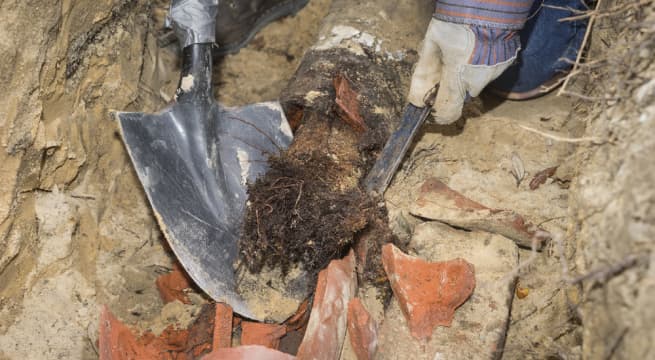Tree Roots in Sewer Line -
Removal Service in Seattle
Multiple items and things can cause clogging and blockage in your sewer line, and tree roots are one of them. Unfortunately, tree roots in the sewer line are a pretty tricky problem to deal with.
If you do not regularly have your sewer line cleaned or maintained, chances are that when the water pressure gets super slow, there are usually tree roots in your sewer line.
Now, this problem needs expert evaluation and solution, so you should look for the removal of roots in the sewer line service in Seattle.

How Do Roots End Up In Our Pipes?
Trees are living organisms, and they have needs like all of us. These needs include a certain amount of moisture and nutrients and if their roots are designed to search for these nutrients.
Unfortunately for homeowners, a home’s sewer line is the perfect source of these nutrients, and tree roots are generally attracted toward a sewer line. This is why roots in drains and sewer lines are a widespread sewer line problem.

Sewer Vapors
Water flows through the sewer line while releasing the vapor into the surrounding soil. This vapor is ultra-rich in moisture and nutrients essential for tree growth. Naturally, the roots are attracted towards it, and it’s the source which is the sewer line. This is the natural cause of tree roots in the sewer.

Sewer Cracks
Sewer vapor tends to seep out from pipe joints and small spaces. These sewer lines are underground, and homeowners usually have no idea they have deteriorated or are cracked unless they have a plumbing problem.
Tree roots are thin and can also invade pipes through these cracks. Homeowners must have their sewer line pipes thoroughly and regularly inspected to avoid tree roots invading them.
If you think you can’t have tree roots in the sewer line because you don't have any trees in your yard or near your sewer line, think again. Tree roots can reach into sewer lines even 2,500 feet away from the actual tree.
How Much Do Tree Roots In Sewer Lines Cost To Remove?
The value of tree roots in sewer lines cost is variable depending on the extent of the invasion and the damage they have done to the drains.
Naturally, when you suspect or detect tree roots in the sewer line, the following steps don’t end at just removing them in the sewer line service.
You also need to look at repairing all the damage done by the roots to ensure your sewage line and the system is running smoothly.

When we consider the cost of tree root removal from the sewer lines, that will cost about $100. However, there are almost always minor or significant damages sustained by your pipes due to tree roots in the sewer lines that need to be repaired.
This means extra cost. In this case, especially if you do not regularly have your pipes inspected, repairs can jump up to $600.
In addition, digging up the ground to remove roots in the drains and the sewer line is mandatory, and it usually comes with extra charges. Usually, the cost of digging is around $50. However, the issue determines the cost, and more extensive digging can charge up to $250.
Next up, you must also consider factoring in the cost of new pipes since a severe burst may need replacement. On average, the cost of new sewer pipes is $3 to $20 per foot. If the entire sewer line has been damaged, the replacement can cost up to $3000.
When you call professional plumbers experienced in this field, they can do a full inspection of tree roots in your sewer line and give you all the options for cost and repairs.
How Does Tree Root Removal In Sewer Lines Work?
You can kill roots in the sewer line in two main ways. You can either try homemade tree root killers, or you can go for a more professional and permanent solution.
DIY Tree Root Killer Solutions
If you decide to take on tree root removal from the sewer line on your own, here are the solutions you can try:

Copper Sulfate Crystals
Foamed copper sulfate crystals are believed to form a poison-like coating around the pipes. Copper sulfate travels far into the roots and removes the absorptive function of the roots.

Rock Salt
Many homeowners use this age-old and tested method to kill tree roots in the sewer line. The trick is to add rock salt down the pipes and flush the area thoroughly after water. Rock salt is believed to kill tree roots.
Permanent Tree Root Killer Solutions
Suppose you don’t want to DIY tree root removal from the sewer line. In that case, you can try more permanent solutions for which you will need help from a professional plumbing company.
Here are the most effective methods of permanent tree root removal from sewer lines:

Pipe Sleeve Insertion
Absorbent pipe sleeves made of resin are inserted into the pipes as they line the inner side of the sewer line. As time passes and the resin hardens, they form pipes free of cracks or holes. Tree roots cannot invade these pipes that are practically good as new.

Mechanical Snake or Auger
A mechanical auger or snake has a head that effectively removes the tree roots in a sewer line. This is a short-term solution, as the roots outside the pipe won’t be killed.

Trenchless Pipe Bursting
If the damage is so extensive that it requires a complete pipe replacement, the best option is trenchless pipe bursting. A steel cable, hydraulic pull, and a bladed steel bursting head replace the damaged pipes. This is a complicated process that requires the services of a specialist plumbing company.

Hydro Jetting
Hydro jetting is the most effective method to remove tree roots in sewer lines. Water is pushed down the pipes at a high pressure of 4000 psi. The hydro jetting machine has different attachments depending on the clog that needs to be removed.
The water pressure can break the tree roots into small pieces, which are later flushed from the pipes using chemicals that ensure tree roots around the sewer line are also killed to avoid future invasion.
Conclusion
In conclusion, tree roots in sewer lines are a complicated yet common problem that can be costly if sewer lines are not properly inspected and maintained regularly. There are ways to remove these tree roots, but the best option is to have professional plumbing comply locate your sewer line and remove the tree roots.

Great Reasons to Choose Fischer Plumbing
Fischer Plumbing is a local Seattle plumbing company that has been helping remove tree roots from sewer lines for our clients for over four decades. We have trained, insured, and licensed professionals with the latest technologies required to kill and remove tree roots while ensuring we make the necessary repairs and replacements.
We work for your satisfaction and are also available for emergency plumbing services. Our certified tree root removal specialists are just a single call away.
Frequently asked questions
Tree roots in the sewer line need to be removed before they can cause significant damage to the pipe structure. You can either use home remedies like rock salt or foamed copper sulfate crystals or engage a professional plumbing company to remove tree roots from drain pipes.
If you let tree roots grow in your sewer lines, eventually, they can cause a pipe burst. A burst pipe will mean water in your house’s foundation and quite hefty repair and replacement costs.
Several chemical drain cleaners in the market have a mix of ingredients that can dissolve existing tree roots in drain pipes while also killing the absorption power of the roots outside the pipe.
Almost all old trees tend to have deep roots that can invade sewer pipes and cause pipe damage, but trees like Sycamore, Maple, Birch, Fig, Elm, Oats, etc., have more probability of causing pipe damage.
Tree roots grow at an exponential rate, which means that if left ignored, they can grow around the sewer pipes and cause pressure that can eventually lead to the crushing of the pipes.

 206-279-3322
206-279-3322